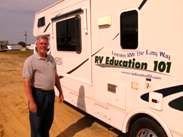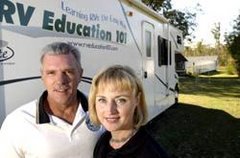In RV's Carbon Monoxide Gas usually results from:
* Exhaust leaks from either a vehicle engine or a generator.
* Improper use of portable gas powered heaters.
* Someone else's vehicle or generator when camping in close quarters.

If your RV doesn't have a carbon monoxide detector you need to purchase a battery operated carbon monoxide detector designed for use in RV's. Test the carbon monoxide detector every time you use the RV. Replace the carbon monoxide detector batteries when you change clocks for daylight savings time.

Now we want to discuss a topic many RVers don't think about, an emergency escape plan. What do you do in the event of an emergency and everybody has to get out of the RV quickly and in an orderly fashion. The National Fire Protection agency requires that RV's have emergency escape windows. Make sure everybody knows where the escape window is located and how to use it.
It's a good idea to practice using it so you are familiar with how to get out of the RV in case of an emergency. You should have an emergency escape plan for the front of the RV and the rear of the RV.
Read the full story with important life saving tips!







No comments:
Post a Comment